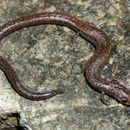Description
provided by AmphibiaWeb articles
A small slender salamander identified by having four digits on the hind limb, a narrow head that is poorly demarcated from the neck, short limbs with very small digits, and a long, slender tail. The species usually has a light dorsal stripe that contains streaks of light pigment, but the overall impression is of a dark brown to black animal. The lateral and ventral surfaces have a rich speckling of tiny white dots. The head is narrower and the hands and feet smaller with less discrete digits than neighboring and sympatric species with which it is easily confused (Batrachoseps diabolicus, B. kawia, B. regius, B. relictus).This species was described in 1998 and was previously known as Batrachoseps attenuatus (until 1980) (Yanev 1979) and then as Batrachoseps nigriventris (Jockusch Wake and Yanev 1998). It is similar in morphology to both of these species, but differs greatly from the former in biochemical traits. It differs from its close relative B. nigriventris in proteins and mitochondrial DNA sequences, but because both species vary geographically in morphology it is not possible to diagnose the two species on morphological grounds. However, B. gregarius is the only member of the genus to have well marked mental glands in sexually active males. It is also typically smaller than B. nigriventris. See another account at californiaherps.com (http://www.californiaherps.com/salamanders/pages/b.gregarius.html).
Distribution and Habitat
provided by AmphibiaWeb articles
Known from the western Sierra Nevada of central California, where it is found in dense coniferous forests in the northern part of its range (Madera County) to the Sierran foothills further south (to central Kern County), where it occurs in oak-woodland and even in grassland at low elevations in areas with harsh (hot and dry) summer climate.
Life History, Abundance, Activity, and Special Behaviors
provided by AmphibiaWeb articles
Active in moist fall, winter and spring months when it is found under logs, rocks and surface debris at high elevations. At low elevations it is found under large rocks in open grassland. Locally abundant. Eggs are laid in the fall at low elevations, but during the spring at high elevations. Eggs are laid communally, and the eggs are either left unguarded, or with only a few females in attendance for clutchs that must have been laid by many individuals (Jockusch and Mahoney 1997).
Life History, Abundance, Activity, and Special Behaviors
provided by AmphibiaWeb articles
The species is relatively widespread, and local populations, although very spotty in its distribution, are locally dense. The geographic range is relatively large and the species occurs in several national forests and in Sequoia National Park. The greatest threats are posed by habitat destruction, especially removal of oaks from low elevation woodland areas.
Relation to Humans
provided by AmphibiaWeb articles
No known relation to humans, but frequently observed.

